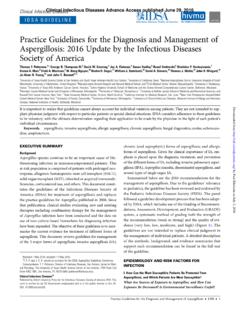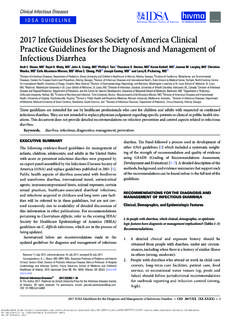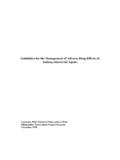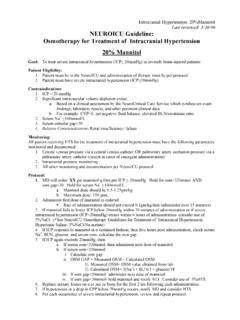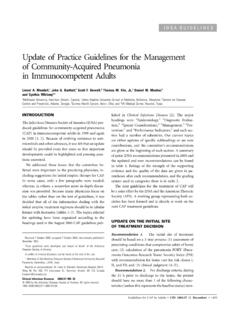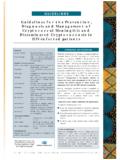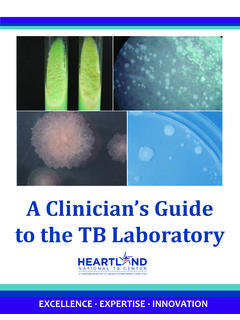Transcription of 2015 Infectious Diseases Society of America (IDSA ...
1 IDSA GUIDELINE. 2015 Infectious Diseases Society of America (IDSA) Clinical Practice Guidelines for the Diagnosis and treatment of Native Vertebral Osteomyelitis in Adultsa Elie F. Berbari,1 Souha S. Kanj,2 Todd J. Kowalski,3 Rabih O. Darouiche,4 Andreas F. Widmer,5 Steven K. Schmitt,6. Edward F. Hendershot,7 Paul D. Holtom,8 Paul M. Huddleston III,9 Gregory W. Petermann,10 and Douglas R. Osmon11. 1. Division of Infectious Diseases , Mayo Clinic College of Medicine, Rochester, Minnesota; 2 Division of Infectious Diseases , American University of Downloaded from at IDSA member on November 20, 2015 .
2 Beirut Medical Center, Lebanon; 3 Division of Infectious Diseases , Gundersen Health System, La Crosse, Wisconsin; 4 Section of Infectious Diseases and Center for Prostheses Infection, Baylor College of Medicine, Houston, Texas; 5 Division of Infectious Diseases , Hospital of Epidemiology, University Hospital Basel, Switzerland; 6 Department of Infectious disease , Cleveland Clinic, Ohio; 7 Department of Infectious Diseases , Duke University, Durham, North Carolina; 8 Department of Internal Medicine, University of Southern California, Los Angeles; 9 Department of Orthopedic Surgery, Mayo Clinic, Rochester, Minnesota; 10 Division of Spine Radiology, Marsh eld Clinic, Wisconsin; and 11 Division of Infectious Diseases , Mayo Clinic, Rochester, Minnesota These guidelines are intended for use by Infectious disease specialists, orthopedic surgeons, neurosurgeons, ra- diologists, and other healthcare professionals who care for patients with native vertebral osteomyelitis (NVO).
3 They include evidence and opinion-based recommendations for the diagnosis and management of patients with NVO treated with antimicrobial therapy, with or without surgical intervention. Keywords. spondylodiscitis; osteomyelitis; Staphylococcus aureus; spine infection; discitis. EXECUTIVE SUMMARY unresponsive to conservative measures and elevated in- ammatory markers with or without fever. Plain Native vertebral osteomyelitis (NVO) in adults is often radiographs of the spine are not sensitive for the early the result of hematogenous seeding of the adjacent disc diagnosis of NVO.
4 Magnetic resonance imaging (MRI). space from a distant focus, as the disc is avascular [1, 2]. of the spine is often required to establish the diagnosis. The diagnosis of NVO can often be delayed several Except in septic patients or patients with neurologic months and may initially be misdiagnosed and mis- compromise, empiric antimicrobial therapy should be managed as a degenerative process [3, 4]. NVO is typi- withheld, when possible, until a microbiologic diagno- cally diagnosed in the setting of recalcitrant back pain sis is con rmed.
5 An image-guided or intraoperative as- piration or biopsy of a disc space or vertebral endplate sample submitted for microbiologic and pathologic Received 8 June 2015 ; accepted 9 June 2015 ; electronically published 29 July examination often establishes the microbiologic or 2015 . pathologic diagnosis of NVO [5]. NVO is commonly a Guidelines cannot always account for individual variation among patients. They are not intended to supplant physician judgment with respect to particular patients monomicrobial and most frequently due to Staphylo- or special clinical situations.
6 IDSA considers adherence to these guidelines to be coccus aureus [6 8]. The concomitant presence of voluntary, with the ultimate determination regarding their application to be made by the physician in light of each patient's individual circumstances. S. aureus bloodstream infection within the preceding Correspondence: Elie F. Berbari, MD, Professor of Medicine, Mayo Clinic College 3 months and compatible spine MRI changes preclude of Medicine, Division of Infectious Diseases , 200 First St SW, MH 5528, Rochester, MN 55905 the need for a disc space aspiration in most patients Clinical Infectious Diseases 2015 ;61(6):e26 46 [1, 9, 10].
7 De nitive therapy should be based on the re- The Author 2015 . Published by Oxford University Press on behalf of the Infectious sults of culture and in vitro susceptibility testing. The Diseases Society of America . All rights reserved. For Permissions, please e-mail: majority of patients are cured with a 6-week course of DOI: antimicrobial therapy, but some patients may need e26 CID 2015 :61 (15 September) Berbari et al surgical debridement and/or spinal stabilization during or after 7. We recommend obtaining bacterial (aerobic and anaerobic).
8 A course of antimicrobial therapy [7, 11 13]. Indications for sur- blood cultures (2 sets) and baseline ESR and CRP in all pa- gery may include the development of neurologic de cits or tients with suspected NVO (strong, low). symptoms of spinal cord compression and evidence of progres- 8. We recommend a spine MRI in patients with suspected sion or recurrence despite proper antimicrobial therapy [6]. NVO (strong, low). Most patients can be followed symptomatically and by monitor- 9. We suggest a combination spine gallium/Tc99 bone scan, or ing laboratory parameters such as C-reactive protein (CRP) and computed tomography scan or a positron emission tomogra- erythrocyte sedimentation rate (ESR) [14].
9 Repeat imaging phy scan in patients with suspected NVO when MRI cannot studies should be reserved for patients failing to show clinical be obtained (eg, implantable cardiac devices, cochlear implants, and or laboratory improvement [15, 16]. claustrophobia, or unavailability) (weak, low). Summarized below are the Infectious Diseases Society of 10. We recommend obtaining blood cultures and serologic America (IDSA) recommendations pertaining to the diagnosis tests for Brucella species in patients with subacute NVO re- and management of patients with NVO.
10 The expert panel fol- siding in endemic areas for brucellosis (strong, low). lowed a process used in the development of other IDSA guide- 11. We suggest obtaining fungal blood cultures in patients with lines, which included a systematic weighting of the strength of suspected NVO and at risk for fungal infection (epidemio- recommendation and quality of evidence using the GRADE logic risk or host risk factors) (weak, low). (Grading of Recommendations Assessment, Development and 12. We suggest performing a puri ed protein derivative (PPD).)
